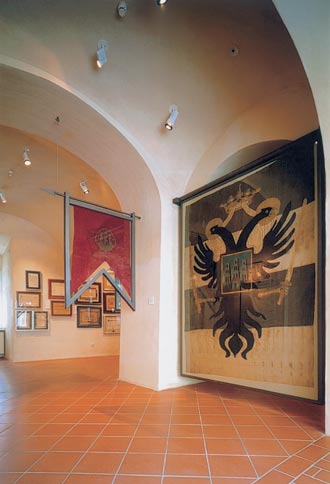Permanent Display 9. The Emblems of the City
 The oldest extant representation of the coat-of-arms as a symbol of the city can be seen in the seal of a fourteenth-century document of Gradec. Like other privileged European towns of that time, Gradec had a seal as early as the 13th century.
The oldest extant representation of the coat-of-arms as a symbol of the city can be seen in the seal of a fourteenth-century document of Gradec. Like other privileged European towns of that time, Gradec had a seal as early as the 13th century.
On the feast of St. Blaise, the patron saint of Gradec, the city council sat in the town hall (vechnicza), built in St. Mark’s Square in the Middle Ages. After the invocation of the Holy Spirit, the councilors issued and sealed documents, elected a new magistrate and jurors, granted citizenship and conferred honours on deserving citizens.
An early fifteenth-century document mentions the town flag flown on the belfry of St. Mark’s. The oldest extant flag of Zagreb dates from the beginning of the 18th century - the coat-of-arms of the town against a red field.
At the end of the 19th century, the city insignia were redesigned and blue became the official colour of Zagreb. The coat-of-arms, the flag, the Lord Mayor’s chain and the town councilor’s insignia are the symbols of the dignity and tradition of the free royal city of Zagreb.
Nada Premerl

